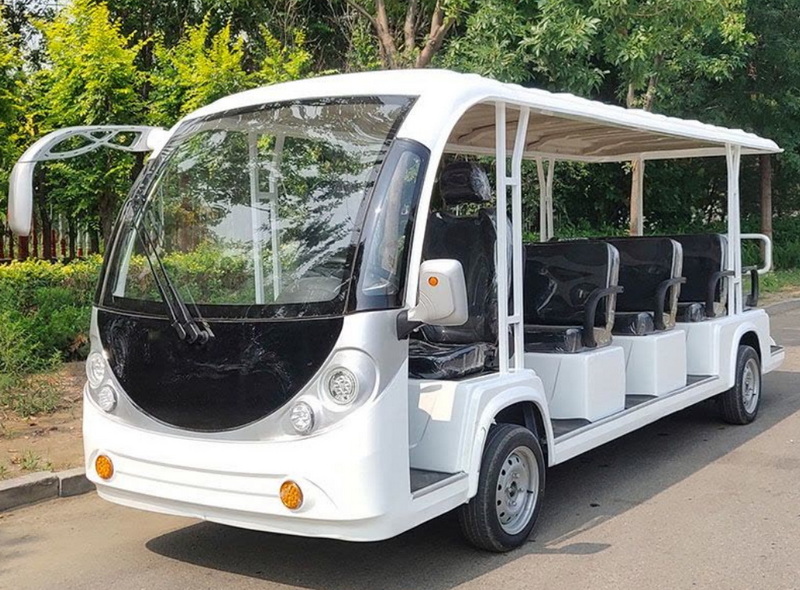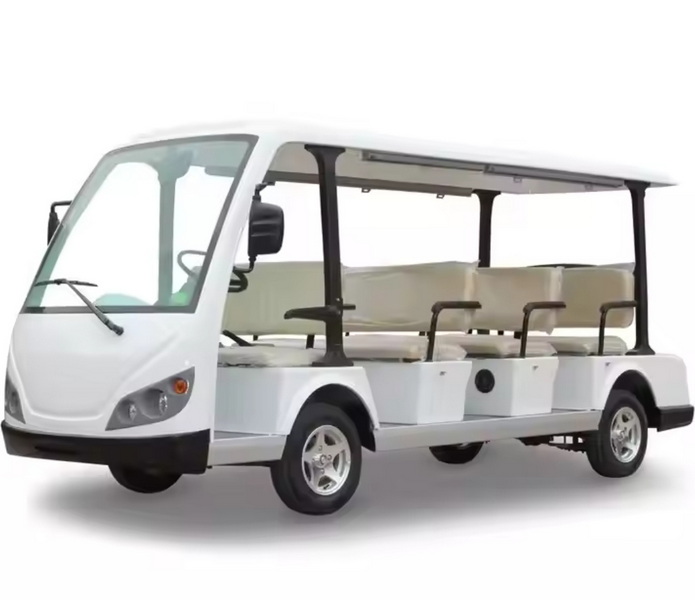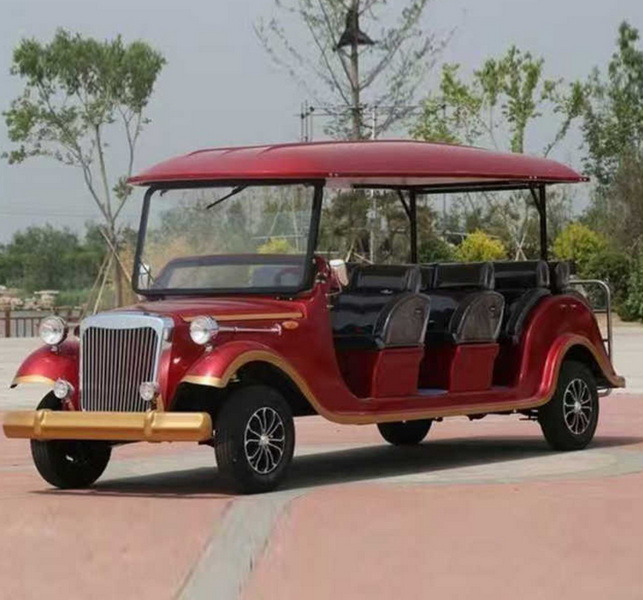Content Menu
● Why Choose Electric Sightseeing Carts for Long-Distance Tours?
● Key Features to Consider for Long-Distance Sightseeing Carts
>> Battery Range
>> Passenger Capacity
>> Comfort
>> Safety Features
>> Terrain Capability
>> Customization
● Top Electric Sightseeing Carts for Long-Distance Tours
>> Bintelli 6PR XL
>> STAR EV Sirius
>> Tomberlin Emerge Beachcomber
>> StandbyMe Electric Golf Cart
>> Evolution D5 Maverick-4 Plus
● Safety Innovations in Modern Electric Sightseeing Carts
>> Smart Sensors and Collision Avoidance
>> One-Pedal Driving
>> Battery Safety
>> Weather Adaptability
>> Pedestrian Alerts
>> Driver Monitoring
● Customization Options for Long-Distance Comfort
>> Seating Arrangements
>> Weather Protection
>> Storage Solutions
>> Entertainment
>> Branding
● Comparison Table: Best Electric Sightseeing Carts for Long-Distance Tours
● Charging and Range Planning for Long-Distance Tours
>> Know Your Range
>> Charging Infrastructure
>> Fast Charging
>> Battery Monitoring
● Applications: Where Are Long-Range Electric Sightseeing Carts Used?
● Maintenance and Longevity of Electric Sightseeing Carts
>> Routine Maintenance
>> Longevity Tips
● Environmental Impact and Sustainability
● Future Trends in Electric Sightseeing Carts
>> Longer Ranges
>> Smart Connectivity
>> Autonomous Operation
>> Enhanced Accessibility
>> Renewable Energy Integration
● Operator Training and Passenger Experience
>> Operator Training
>> Enhancing the Passenger Experience
● Conclusion
● FAQ
>> 1. What is the average range of an electric sightseeing cart for long-distance tours?
>> 2. How long does it take to fully charge an electric sightseeing cart?
>> 3. Are electric sightseeing carts suitable for all weather conditions?
>> 4. What safety features should I look for in a long-distance sightseeing cart?
>> 5. Can electric sightseeing carts be customized for specific tour needs?
Electric sightseeing carts are transforming the way we explore large tourist destinations, resorts, campuses, and urban attractions. As sustainability becomes a growing concern, these vehicles offer an eco-friendly, quiet, and comfortable alternative to traditional gas-powered shuttles. For long-distance tours, where range, passenger comfort, and reliability are essential, selecting the right electric sightseeing cart is crucial.
This comprehensive guide will help you understand the key features, benefits, and leading models of electric sightseeing carts designed for long-distance tours. We will also explore their applications, safety innovations, customization options, and future trends, ensuring you have all the information you need to make an informed decision.

Why Choose Electric Sightseeing Carts for Long-Distance Tours?
Electric sightseeing carts have surged in popularity due to their numerous advantages:
- Eco-Friendly Operation: With zero emissions, these carts help preserve the environment and reduce noise pollution, making them ideal for natural parks, resorts, and urban centers.
- Cost-Effective: Electric carts are more economical in the long run, with lower energy and maintenance costs compared to gasoline-powered vehicles.
- Quiet Ride: The near-silent operation enhances the sightseeing experience, allowing passengers to immerse themselves in the surroundings without the distraction of engine noise.
- Customizable: Manufacturers offer a range of customization options, from seating arrangements to onboard entertainment, ensuring the carts meet specific operational needs.
- Safety: Modern electric carts are equipped with advanced safety features, providing peace of mind for operators and passengers alike.
Key Features to Consider for Long-Distance Sightseeing Carts
When selecting an electric sightseeing cart for extended tours, it's important to evaluate several critical factors:
Battery Range
The battery's capacity determines how far the cart can travel on a single charge. For long-distance tours, look for models with high-capacity lithium-ion batteries, offering at least 40 miles per charge, with premium models exceeding 100 miles.
Passenger Capacity
Sightseeing carts come in various sizes, typically accommodating 4 to 14 passengers. Assess your typical group size and choose a cart that provides ample space without sacrificing comfort.
Comfort
Long tours require comfortable seating, effective suspension systems, and weather protection. Features such as padded seats, adjustable backrests, and climate control can greatly enhance the passenger experience.
Safety Features
Safety is paramount, especially on long routes. Look for carts with seat belts, advanced braking systems, smart sensors, and pedestrian alerts.
Terrain Capability
If your tours cover mixed terrains, select a cart with robust suspension, high ground clearance, and all-terrain tires.
Customization
Consider options like storage compartments, entertainment systems, accessibility features, and branding to tailor the cart to your specific needs.
Top Electric Sightseeing Carts for Long-Distance Tours
Here are some of the best electric sightseeing carts for long-distance travel, chosen for their range, comfort, and reliability:
Bintelli 6PR XL
- Range: Up to 105 miles per charge
- Capacity: 6 passengers
- Features: Powerful AC motor, T1 Trojan batteries, commercial-grade build, ideal for resorts and large campuses.
STAR EV Sirius
- Range: Up to 75 miles per charge
- Capacity: 4-6 passengers
- Features: Premium adjustable seating, comfort-focused design, suitable for suburban and retirement communities.
Tomberlin Emerge Beachcomber
- Range: Up to 60 miles per charge
- Capacity: 4-6 passengers
- Features: Street-legal, extended-range battery, safety features like seat belts and turn signals.
StandbyMe Electric Golf Cart
- Range: Up to 50 miles per charge
- Capacity: 4 passengers
- Features: High-efficiency 5,000W AC motor, adjustable cargo bed, ideal for mixed-use environments.
Evolution D5 Maverick-4 Plus
- Range: Approximately 40-50 miles per charge
- Capacity: 4 passengers
- Features: 8.4 HP AC engine, luxury seats, touchscreen controls, backup camera.
Safety Innovations in Modern Electric Sightseeing Carts
Safety is a top priority in modern electric sightseeing carts, especially for long-distance tours. Here are some of the latest innovations:
Smart Sensors and Collision Avoidance
Advanced sensors detect obstacles, pedestrians, and other vehicles, triggering automatic braking or alerts to prevent accidents.
One-Pedal Driving
This feature simplifies operation, allowing the driver to accelerate and decelerate with a single pedal, resulting in smoother stops and starts.
Battery Safety
High-quality lithium-ion batteries come with thermal management and short-circuit protection, ensuring safe operation even during extended use.
Weather Adaptability
Anti-slip mats, weatherproof seating, and corrosion-resistant materials allow carts to operate safely in various weather conditions.
Pedestrian Alerts
Low-volume horns or sound systems alert pedestrians at low speeds, reducing the risk of accidents in crowded areas.
Driver Monitoring
Some models include fatigue and alcohol sensors to ensure the driver is alert and capable of operating the vehicle safely.

Customization Options for Long-Distance Comfort
Personalization is key to maximizing comfort and utility on long tours. Popular customization options include:
Seating Arrangements
Carts can be configured from 4 to 14 seats, with options for VIP layouts, wheelchair accessibility, and family-friendly designs.
Weather Protection
Canopies, windshields, and fully enclosed cabins protect passengers from sun, rain, and wind, ensuring comfort in all seasons.
Storage Solutions
Built-in compartments for luggage, equipment, or refreshments make long tours more convenient for guests.
Entertainment
Onboard audio systems, video screens, and charging ports keep passengers entertained and connected.
Branding
Custom colors, logos, and wraps allow businesses to showcase their brand on every tour.
Comparison Table: Best Electric Sightseeing Carts for Long-Distance Tours
| Model | Max Range (miles) | Passenger Capacity | Key Features | Best For |
| Bintelli 6PR XL | 105 | 6 | Long-range, commercial-grade, robust build | Resorts, large campuses |
| STAR EV Sirius | 75 | 4-6 | Premium comfort, adjustable seating | Suburban, retirement use |
| Tomberlin Emerge Beachcomber | 60 | 4-6 | Street-legal, extended battery, safety focus | Mixed on-road/off-road |
| StandbyMe Electric Golf Cart | 50 | 4 | High-power motor, cargo bed | Mixed-use, farms, beaches |
| Evolution D5 Maverick-4 Plus | 40-50 | 4 | Luxury seats, tech features | Golf courses, urban touring |
Charging and Range Planning for Long-Distance Tours
Efficient charging and route planning are essential for successful long-distance tours:
Know Your Range
Always check the manufacturer's stated range and consider real-world factors such as passenger load, terrain, and weather, which can affect battery life.
Charging Infrastructure
Plan routes to include charging stations at key stops, or ensure that destination facilities offer charging options for electric carts.
Fast Charging
Some carts support rapid charging, reducing downtime and increasing operational efficiency.
Battery Monitoring
Digital dashboards provide real-time battery status, helping drivers plan charging stops and avoid unexpected power loss.
Applications: Where Are Long-Range Electric Sightseeing Carts Used?
Electric sightseeing carts are versatile and can be found in a wide variety of settings:
- Tourist Attractions: Historical sites, theme parks, botanical gardens, and zoos.
- Resorts and Hotels: Shuttling guests across large properties, from lobbies to villas or activity centers.
- Urban Tours: City sightseeing, hop-on-hop-off services, and guided tours.
- Nature Parks: Eco-friendly exploration of protected areas, wildlife reserves, and scenic trails.
- Event Venues: Transporting guests between pavilions, stages, or parking areas at large events and festivals.
- Educational Campuses: Moving students, staff, and visitors efficiently across university or corporate campuses.
Maintenance and Longevity of Electric Sightseeing Carts
Proper maintenance is essential to maximize the lifespan and performance of electric sightseeing carts, especially for long-distance use.
Routine Maintenance
- Battery Care: Regularly check battery health, keep terminals clean, and follow manufacturer guidelines for charging cycles.
- Tire Inspection: Ensure tires are properly inflated and check for wear, especially if the cart is used on mixed terrain.
- Brake System: Inspect and maintain brakes regularly for safe operation.
- Electrical Systems: Periodically check wiring, lights, and sensors for proper function.
Longevity Tips
- Store Carts Properly: When not in use, store carts in a dry, sheltered area to protect against weather damage.
- Scheduled Servicing: Follow the manufacturer's recommended service intervals for major components.
- Software Updates: For modern carts with digital systems, keep software up to date for optimal performance and security.
Environmental Impact and Sustainability
Electric sightseeing carts contribute significantly to sustainability efforts:
- Zero Emissions: Unlike gas-powered vehicles, electric carts produce no tailpipe emissions, helping to reduce air pollution.
- Quiet Operation: Minimizes noise pollution, preserving the tranquility of natural and urban environments.
- Recyclable Components: Many manufacturers use recyclable materials in their construction, further reducing environmental impact.
- Energy Efficiency: Electric motors are far more efficient than internal combustion engines, translating to lower overall energy consumption.
Future Trends in Electric Sightseeing Carts
The future of electric sightseeing carts is bright, with several exciting trends on the horizon:
Longer Ranges
Advances in battery technology, such as solid-state batteries, promise even greater distances per charge, reducing the need for frequent stops.
Smart Connectivity
Integration with smart city infrastructure will enable real-time navigation, traffic updates, and seamless route adjustments, enhancing the tour experience.
Autonomous Operation
Self-driving carts are being developed for guided tours, offering new levels of convenience and accessibility.
Enhanced Accessibility
Manufacturers are focusing on features for passengers with mobility challenges, such as low-floor designs, ramps, and specialized seating.
Renewable Energy Integration
Some carts now feature solar panels or can be charged using renewable energy sources, further reducing their carbon footprint.
Operator Training and Passenger Experience
Operator Training
Proper training is vital for safe and efficient operation, especially on long-distance routes. Training programs should cover:
- Vehicle controls and dashboard features
- Safe driving practices for various terrains and weather conditions
- Emergency procedures
- Passenger assistance and customer service
Enhancing the Passenger Experience
To ensure a memorable tour, focus on:
- Comfort: Provide amenities such as water, snacks, and blankets for longer tours.
- Information: Use audio guides or live commentary to enrich the sightseeing experience.
- Accessibility: Ensure carts are easy to board and exit, with clear signage and assistance as needed.
- Cleanliness: Maintain high standards of cleanliness, especially for shared vehicles.
Conclusion
Electric sightseeing carts are revolutionizing long-distance tours by offering a sustainable, comfortable, and innovative mode of transport. With models like the Bintelli 6PR XL, STAR EV Sirius, and Tomberlin Emerge Beachcomber leading the way, operators can provide guests with an enjoyable, safe, and environmentally friendly experience. By considering factors such as range, comfort, safety, and customization, you can select the perfect cart for your needs and ensure every tour is a success.

FAQ
1. What is the average range of an electric sightseeing cart for long-distance tours?
Most high-end electric sightseeing carts offer a range between 40 and 105 miles per charge, depending on battery capacity, passenger load, and terrain.
2. How long does it take to fully charge an electric sightseeing cart?
Charging times vary by battery type and charger, but most lithium-ion powered carts can be fully charged within 6-8 hours using standard chargers. Fast-charging options can reduce this time significantly.
3. Are electric sightseeing carts suitable for all weather conditions?
Many modern carts are equipped with weatherproof features such as canopies, enclosed cabins, anti-slip mats, and corrosion-resistant materials, making them suitable for various weather conditions.
4. What safety features should I look for in a long-distance sightseeing cart?
Key safety features include smart sensors for obstacle detection, one-pedal driving, seat belts, pedestrian alerts, and advanced battery safety systems.
5. Can electric sightseeing carts be customized for specific tour needs?
Yes, most manufacturers offer customization options including seating arrangements, storage, weather protection, entertainment systems, and branding to tailor the cart to specific operational requirements.










































